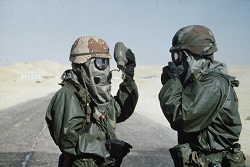Farnaz Alimehri
February 26, 2016
The following is an excerpt of an article published February 25 by the Georgetown Security Studies Journal.
On February 12, 2016, CIA Director John Brennan confirmed that the Islamic State of Iraq and the Levant (ISIL) used chemical weapons – specifically mustard and chlorine gas – and may use them again, as it has the capacity to  produce more. US official speculation about ISIL’s chemical weapons use dates back to December 2012, and this
produce more. US official speculation about ISIL’s chemical weapons use dates back to December 2012, and this
week the Organization for the Prohibition of Chemical Weapons (OPCW) likewise confirmed that mustard gas has been used in Iraq and that sarin gas has been used in Syria.
ISIL’s chemical weapons use raises serious concerns about non-state actors’ access to weapons of mass destruction (WMD) and reinforces fears of a possible terrorist attack with chemical, biological, radiological, and/or nuclear (CBRN) weapons in the West. The European Union (EU) member states have begun individually training their forces on how to respond to a CBRN attack, and the United States has also been reconsidering various options to mitigate the impact of an unconventional attack on US soil.
These preparations beg the question: what makes a CBRN attack more concerning than a conventional one? While conventional weapons have historically inflicted many more casualties than unconventional weapons, ISIL’s acquisition and use of chemical weapons nonetheless requires a deeper look at WMD. Certain elements of unconventional weapons distinguish them from regular weapons, making them particularly worrisome to the West.
